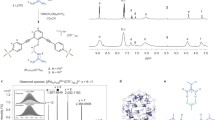Abstract
Because of the relative ease to modify, functionalize, and synthesize polysiloxanes, these compounds offer interesting possibilities to greatly influence the properties of a catalytic system. These potentials are illustrated with three catalytic systems. In the first system, siloxane nanocages are shown to exhibit confinement effects by strongly modifying the protonation affinity of internal amine groups and by changing the activity and product selectivity in a reaction catalyzed by these groups. In the second example, the length of the siloxane backbone of a bis(pyridyl)siloxane ligand is shown to be critical both in stabilizing a Pd acetate complex catalyst in selective oxidation of benzyl alcohol, and in determining the dependence of the reaction rate on the pyridyl concentration in the reaction mixture. In the third example, polysiloxanes are shown to be useful in the preparation of a supported Pd catalyst in which the metal loading and particle size can be independently controlled.










Similar content being viewed by others
References
Foerster T, Schunk SA, Jentys A, Lercher JA (2011) Co and Mn polysiloxanes as unique initiator-catalyst-systems for the selective liquid phase oxidation of o-xylene. Chem Commun 47(11):3254–3256
Alder KI, Sherrington DC (2000) Synthesis and characterization of Ti(IV) and Zr(IV)-containing elastomeric polysiloxane networks: a possible route to interesting heterogeneous catalysts. J Mater Chem 10(5):1103–1111
Bronger RPJ, Bermon JP, Reek JNH, Kamer PCJ, van Leeuwen PWNM, Carter DN, Licence P, Poliakoff M (2004) The immobilization of phenoxaphosphine-modified xanthene-type ligand on polysiloxane support and application thereof in the hydroformylation reaction. J Mol Catal A 224(1–2):145–152
Frauchiger S, Baiker A (2003) Saucy-Marbet ketonization in a continuous fixed-bed catalytic reactor. Appl Catal A 253(1):33–48
Sullivan AC, Wilson JRH (2002) Polysiloxanes containing phosphonic groups used as effective catalysts and ion exchange resins. 2002-GB69 2002055587, 20020109
Pouliquen L, Coqueret X (1996) Polysiloxanes with benzophenone side groups. Factors affecting their efficiency as free radical polymerization photoinitiators. Macromol Chem Phys 197(12):4045–4060
Ringe D, Petsko GA (2008) How enzymes work. Science 320:1428
Lee J-K, Kung MC, Suh Y-W, Kung HH (2008) Discrete molecular-sized nanocages derived from disintegratable dendrimer templates. Chem Mater 20(2):373–375
Suh Y-W, Kung MC, Wang Y, Kung HH (2006) Size-selective shell cross-linked interior functionalized siloxane nanocages. J Am Chem Soc 128(9):2776–2777
Lee J-K, Suh Y-W, Kung MC, Downing CM, Kung HH (2007) Efficient synthesis of immolative carbamate dendrimer with olefinic periphery. Tetrahedron Lett 48(28):4919–4923
Downing CM, Missaghi MN, Kung MC, Kung HH (2011) Design and synthesis of readily degradable acyloxysilane dendrimers. Tetrahedron. doi:10.1016/j.tet.2011.07.068
Barbas CF III, Heine A, Zhong G, Hoffmann T, Gramatikova S, Björnestedt R, List B, Anderson J, Stura EA, Wilson IA, Lerner RA (1997) Immune versus natural selection: antibody aldolases with enzymic rates but broader scope. Science 278:2085–2092
Henao JD, Suh Y-W, Lee J-K, Kung MC, Kung HH (2008) Striking confinement effect: AuCl4− binding to amines in a nanocage cavity. J Am Chem Soc 130(48):16142–16143
Missaghi MN, Galloway JM, Kung HH (2010) Bis(pyridyl)siloxane oligomeric ligands for palladium(II) acetate: synthesis and binding properties. Organometallics 29(17):3769–3779
Missaghi MN, Galloway JM, Kung HH (2011) Bis(pyridyl)siloxane-Pd(II) complex catalyzed oxidation of alcohol to aldehyde: effect of ligand tethering on catalytic activity and deactivation behavior. Appl Catal A 391(1–2):297–304
Fu B, Missaghi MN, Downing CM, Kung MC, Kung HH, Xiao G (2010) Engineered polymer for controlled metal nanoparticle synthesis. Chem Mater 22(7):2181–2183
Acknowledgments
Financial support of the work presented here was primarily from the Department of Energy, Basic Energy Sciences over the years Grant No. DE-FG02-01ER15184 and DE-FG02-03ER15457. Contribution from the Dow Chemicals Company is also acknowledged. The authors also acknowledged many delightful discussions with former students and post-doctoral fellows, including those who did not participate in the cited references.
Author information
Authors and Affiliations
Corresponding author
Rights and permissions
About this article
Cite this article
Missaghi, M.N., Kung, M.C. & Kung, H.H. Polysiloxanes in Catalysis and Catalyst Preparation: Opportunities for Control of Catalytic Processes. Top Catal 55, 99–107 (2012). https://doi.org/10.1007/s11244-012-9778-2
Published:
Issue Date:
DOI: https://doi.org/10.1007/s11244-012-9778-2




